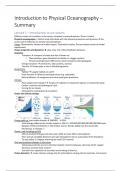Zusammenfassung
Summary Introduction to Physical Oceanography
- Kurs
- Hochschule
This file includes all 14 lectures given in the course in . The course supervisor was Roderik van der Wal. It includes all the information from the PowerPoints and a lot of information that was only told during the lectures (I made very elaborate notes). It also includes additions that were importa...
[ Mehr anzeigen ]



